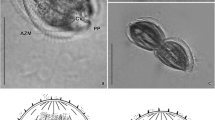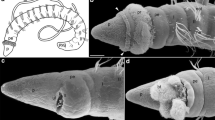Summary
This light- and electron-microscopic study has investigated the structure, the morphodynamics of discharge, and the impact of the stenotele cyst of Hydra attenuata (Hydrozoa, Cnidaria) on the prey's integument. The triggered capsule, which is ejected from the cell, discharges its tubular content (shaft, stylets and tubule) by a process of evagination. In doing so the three joined stylets punch a hole into the cuticle of the prey through which the long evaginating tubule penetrates into the interior of the target. The behaviour of the tubule is described in detail and the functional significances of the various parts of the capsule are discussed.
Similar content being viewed by others
References
Campbell RD (1977) Structure of Hydra nematocysts: Geometry of the Connection between the Butt and Tubule. Trans Am Microsc Soc 96:149–152
Carré D (1980) Hypothèse sur le mécanisme de l'évagination du filament urticant des cnidocystes. European Journ Cell Biol 2:265–271
Carré D, Carré C (1980) On triggering and control of cnidocyst discharge. Mar Behav Physiol 7:109–117
Chapman GB (1961) The fine structure of the stenoteles of Hydra. In: Lenhoff HM, Loomis WF (eds) The Biology of Hydra. Univ Miami Press, Coral Gables, Florida, p 131–151
Chapman GB, Tilney LG (1959) Cytological studies of the nematocysts of Hydra. II. The stenoteles. J Biophys Biochem Cytol 5:79–84
Cormier SM, Hessinger DA (1980) Cellular basis for tentacle adherence in the Portuguese man-of-war (Physalia physalis). Tissue and Cell 12:713–721
Ewald A (1915) Ueber den Bau, die Entladung und die Entwicklung der Nesselkapseln von Hydra und Porpita mediterranea nebst einigen histologischen Bemerkungen über die letztere Form. Verhandl Heidelb Naturk Med Verein N.F. 13:303–354
Glaser OC, Sparrow CM (1915) The physiology of nematocysts. J Exp Zool 6:361–383
Holstein T (1981) The morphogenesis of nematocytes in Hydra and Forskålia: an ultrastructural study. J Ultrastr Res 75:276–290
Holstein T (1980) An ultrastructural and kinematographic study of the nematocyst morphogenesis in selected coelenterate species. In: Tardent P, Tardent R (eds) Developmental and cellular biology of coelenterates. Elsevier North Holland Biomedical Press, Amsterdam New York Oxford, p 313–318
Jones CS (1947) The control and discharge of nematocysts in Hydra. J Exp Zool 105:25–60
Kline ES (1961) Chemistry of nematocyst capsule and toxin of Hydra littoralis. In: Lenhoff HM, Loomis WF (eds) The biology of Hydra. Univ Miami Press, Coral Gables, Florida, p 153–168
Kline ES, Waravdekar VS (1959) Toxic effects of a material isolated from Hydra littoralis. Am Soc Pharmacol Exp Ther 1:62
Kline ES, Waravdekar VS (1960) Inhibitor of succinoxidase activity from Hydra littoralis. J Biol Chem 235:1803–1808
Lentz TL (1966) The cell biology of Hydra. North-Holland Publ Co, Amsterdam, p 1–199
Loomis WF, Lenhoff HM (1956) Growth and sexual differentiation of Hydra in mass culture. J Exp Zool 132:555–574
Lubbock R, Amos WB (1981) Removal of bound calcium from nematocyst content causes discharge. Nature 290:500–501
Lubbock R, Gupta BL, Hall TA (1981) Novel role of calcium in exocytosis: Mechanism of nematocyst discharge as shown by X-ray microanalysis. Proc Natl Acad Sci USA 78:3624–3628
Mariscal RN (1974) Nematocysts. In: Muscatine L, Lenhoff HM (eds) Coelenterate biology. Academic Press Inc, New York San Francisco London, p 129–178
Mascorro JA, Ladd HW, Yates RD (1976) Rapid infiltration of biological tissue utilizing n-hexenyl succinic anhydride (HXSA)/vinyl cyclohexene dioxide (VCD), an ultra-low viscosity embedding medium. 34th Ann Proc EMSA p 346–347
Mattern LFT, Park HD, Daniel WA (1965) Electron microscope observations on the structure and discharge of the stenotele of Hydra. J Cell Biol 27:621–638
Mueller JF (1950) Some observations on the structure of hydra with particular reference to the muscular system. Trans Am Microsc Soc 69:133–147
Picken LER (1953) A note on the nematocysts of Corynactis viridis. Quart J Micr Sci 94:203–227
Picken LER (1957) Stinging capsules and designing nature. New Biol 22:56–71
Picken LER, Skaer RJ (1966) A review of researches on nematocysts. In: Rees WJ (ed) The Cnidaria and their evolution. Symp Zool Soc London 16: pp19–50
Rathmayer W, Jessen B (1975) Effect of toxins of sea anemones on neuromuscular transmission. Naturwissenschaften 62:538
Reisinger E (1937) Der Entladungsvorgang der Nesselkapseln. Zool Anz Suppl 10:311–315
Reynolds ES (1963) The use of lead citrate at high pH as an electron opaque stain in electron microscopy. J Cell Biol 17:208–210
Rich F, Tardent P (1969) Untersuchungen zur Nematocytendifferenzierung bei Hydra altenuata. Rev Suisse Zool 76:779–787
Robson EA (1953) Nematocysts of Corynactis: The activity of the filament during discharge. Quart J Microsc Sci NS 94:229–235
Sato T (1967) A modified method for lead staining of thin sections. J Electronmicr 16:133–140
Schneider KC (1900) Mittheilungen über Siphonophoren. V. Nesselzellen. Arb Zool Inst Wien 12:1–107
Schulze P (1922) Der Bau und die Entladung der Penetranten bei Hydra attenuata. Arch Zellforsch 16:383–438
Slautterback DB (1961) Nematocyst development. In: Lenhoff HM, Loomis WF (eds) Univ Miami Press Coral Gables, Florida, p 77–129
Slautterback DB, Fawcett DW (1959) The development of the cnidoblast in Hydra. An electron microscope study of cell differentiation. J Biophys Biochem Cytol 5:441–452
Spurr AR (1969) A low-viscosity epoxy resin embedding medium for electron microscopy. J Ultrastr Res 26:31–42
Tardent P, Honegger Th, Baenninger R (1980) About the function of stenoteles in Hydra attenuata Pall. In: Tardent P, Tardent R (eds) Developmental and cellular biology of coelenterates. Elsevier North Holland Biomedical Press, Amsterdam New York Oxford, p 331–336
Toppe O (1910) Untersuchungen über Bau und Funktion der Nesselzellen der Cnidaria. Teil I. Der feinere Bau der Nesselzellen sowie systematische Beiträge zur Kenntnis des Genus Hydra. Zool Jahrb (Morph) 29:191–280
Weber G, Honegger Th, Tardent P (1978) Neuorientierung der Nesselwanderung bei Hydra attenuata Pall durch transplantierte Tentakel. Rev Suisse Zool 85:768–774
Weill R (1930) Essai d'une classification des nématocystes des Cnidaires. Bull Biol France Beige 64:141–156
Werner B (1965) Nesselkapseln der Cnidaria mit besonderer Berücksichtigung der Hydroida. Helgoländer wiss Meeresunters 12:1–39
Westfall J (1965) The morphology and development of nematocysts and associated structures in the Cnidaria. PhD Thesis Univ, California, Berkeley
Westfall J (1970) The nematocyte complex in a Hydromedusa Gonionemus vertens. Z Zellforsch 110:457–470
Will L (1919) Die Volumenreduktion der Nesselkapseln bei der Explosion und infolge “Alterns”. Anat Hefte 57:483–553
Yanagita TM (1960) Physiological mechanisms of nematocyst response in sea anemone. III excitation and anaesthetization of the nettling response. Comp Biochem Physiol 1:123–139
Yanagita TM (1973) The “cnidoblast” as an excitable system. Publ Seto Mar Biol Lab 20:675–693
Zumstein A (1973) Regulation der Nematocyten-Produktion bei Hydra attenuata Pall. With Roux's Arch 173:294–318
Author information
Authors and Affiliations
Additional information
This work was supported by the Swiss National Science Foundation (Grant 3.317-0.78). The authors wish to acknowledge gratefully the technical help of Mrs. R. Baenninger, Miss C. Völzke and Mr. U. Jauch. They are also indebted to Dr. P. Späth (Blutspendedienst SRK) who introduced them to the use of Na-alginate
Rights and permissions
About this article
Cite this article
Tardent, P., Holstein, T. Morphology and morphodynamics of the stenotele nematocyst of Hydra attenuata Pall. (Hydrozoa, Cnidaria). Cell Tissue Res. 224, 269–290 (1982). https://doi.org/10.1007/BF00216873
Accepted:
Issue Date:
DOI: https://doi.org/10.1007/BF00216873




